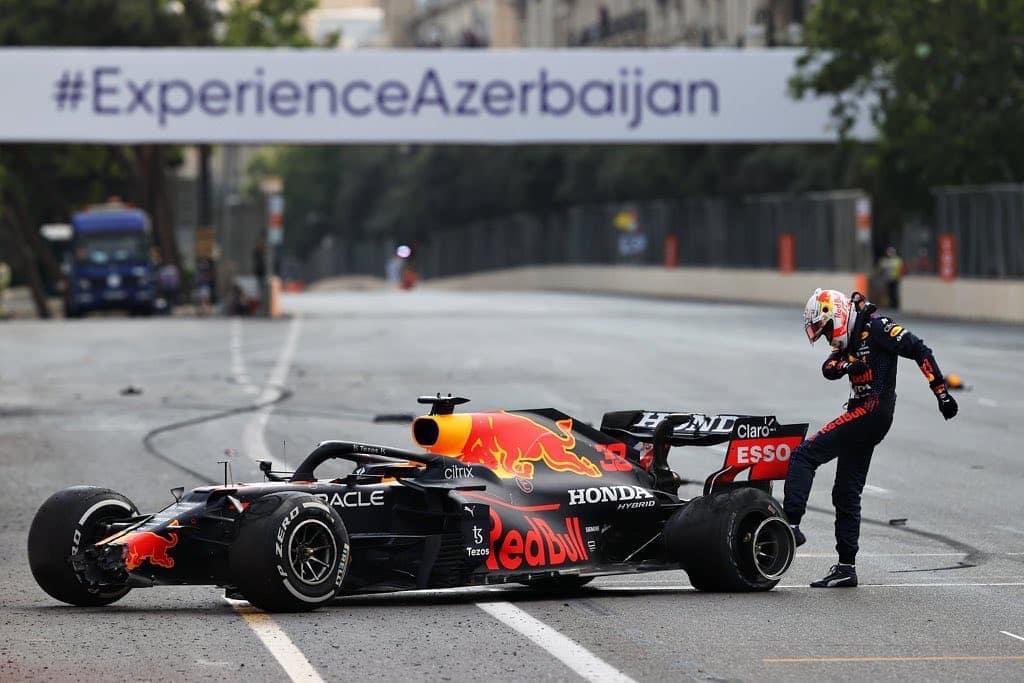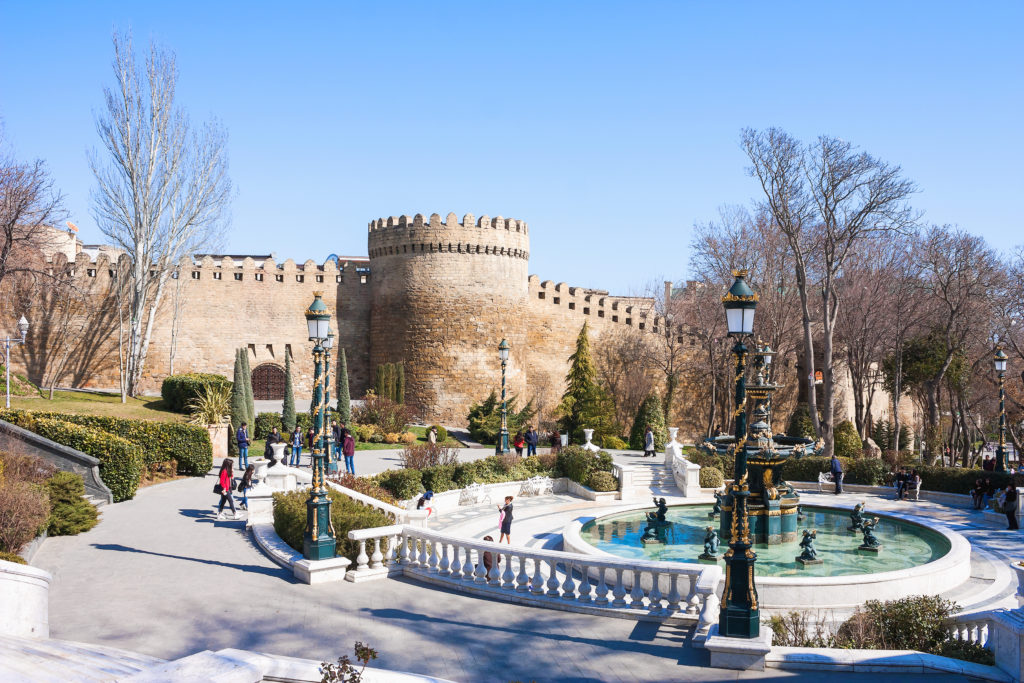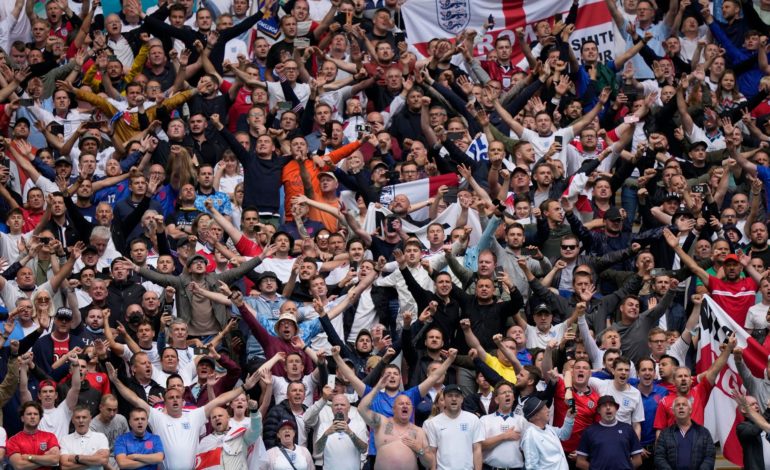Located on the Caspian Sea, the 2022 Azerbaijan GP will take place this weekend in the medieval metropolis of Baku. Every year, the streets of Baku are transformed into a Formula 1 track for Grand Prix racing. The very long main straight with DRS is situated along the shoreline, followed by several 90-degree left-hand corners that lead into the Old City, then some higher speed corners to the finish line. This temporary street circuit is ruthless – similar to Monaco – so keeping the car out of the barriers will be imperative. The following are potential challenges that teams and drivers will be considering this weekend at the Azerbaijan GP.

The First Corner
It will all kick off in the first corner, the end of the long and wide straight, and drivers will be using DRS to try to overtake. Through the years, we have seen cars three-wide into the braking zone of the 90-degree left-hand corner. We have also seen drivers bailing out of overtakes and using the run-off area.
At the 2021 Azerbaijan GP, Lewis Hamilton lined up second for a Red Flag restart on Lap 50/51 with smoking wafting up from his brake ducts. Into Turn 01, Hamilton fought the Red Bull of Sergio Perez, when his Mercedes W12 locked up under braking and went straight on, into the run-off. Perez was quick to take the lead and his second victory in F1.
#AzerbaijanGP ?? #F1 #Formula1
— Rex Nobow DCLXVI ++ (@rexnobowdclxvi) June 6, 2022
In the last year Lewis Hamilton accidentally pushed the “magic button”. This error ruined Hamilton’s Baku GP. If Hamilton had finished the race at P2, he would have win the Championship ?. pic.twitter.com/zXgCi4AMpy
After Monaco, two weeks ago, some drivers and fans were complaining about the lack of overtaking opportunities. Baku guarantees more overtaking than Monaco.
“It is the most hectic Turn 01 in the whole calendar. You can see by the safety car restarts for yourself,” said Alex Albon.
Daniel Ricciardo and Max Verstappen came together at the #AzerbaijanGP in 2018. #F1 #DanielRicciardo #MaxVerstappen #RedBullRacing #Crash pic.twitter.com/fFQlyzNZF1
— Motorsport Images (@MSI_Images) June 9, 2022
In 2018, the Red Bull cars of Max Verstappen and Daniel Ricciardo were battling every lap, the team elected to let them race. They touched earlier in the race, and then Verstappen dove up the inside, and squeezed Ricciardo wide at Turn 03; the tension was building. After Ricciardo gained track position on Verstappen, he earned the premium strategy. However, to make the strategy work, he would have to overtake his teammate once more. Ricciardo lined up Verstappen for a move on the inside into the first corner. Verstappen weaved to cover the inside, and the two collided into the braking zone of Turn 01.
The DRS zone is such that cars can gain on their opponents by driving in their slipstream and overtaking before the braking zone of Turn 01. This makes it difficult to lead this race, as the driver behind tends to have the advantage. Drivers engaged in a tight battle with one another will continue to swap places. Or they will get frustrated by the constant overtaking and make a desperate move, both offensively and defensively, in the case of the Red Bull in 2018.
Safety Cars and Red Flags
Crashes are likely in Baku. The cars race at high speeds in certain corners, and running wide on the corner exits will result in early retirement. Thus, the teams will have to factor Safety Car(s) into their race strategy. Perhaps, some teams will choose to gamble on a late safety car, and wait to pit for new tires.

When Hamilton lost out in Baku last year, Verstappen also lost out when his rear tire failed at the end of Lap 46/51. He crashed violently into the wall at around 200 mph. He was leading the race after a brilliant battle with Lewis Hamilton on track and in the pits. Then, the Aston Martin of Lance Stroll crashed after the final corner at high speed. Carbon fiber debris was strewn on the main straight, which promoted a Safety Car.
The Dutchman maintained his lead on the restart, until the puncture that sent him into the wall. The costly puncture for Verstappen’s championship was likely caused by sharp debris from the Stroll incident. Verstappen’s shunt brought out a Red Flag with two laps remaining. At which point Hamilton lost out, and Perez finished the job for Red Bull.
In qualifying that same weekend in 2021, there were two Red Flags in Q1 after Stroll and former F1 driver, Antonio Giovinazzi, crashed into the barrier at Turn 15. In Q2, Daniel Ricciardo locked up at Turn 03 and hit the wall, for the third Red Flag of qualifying. Then, in the final minute of Q3, there was another Red Flag. Yuki Tsunoda braked far too late into Turn 03, he hit the same barrier as Ricciardo; Carlos Sainz spun into the run-off when he tried to avoid the Alpha Tauri car.
Baku Qualifying: Stroll and Giovinazzi crash out https://t.co/E9y12lWKbZ pic.twitter.com/Cfuyo8TVYH
— Flyin18T Motorsports (@Flyin18T) June 5, 2021
The session was brought to an end prematurely, while several cars were trying to improve their time. Charles Leclerc took pole in a similar fashion as he did in Monaco two weeks ago. Crashes are so common in Baku, and overtakes are fast and frequent. Expect the race to be shaken up by Safety Cars, which group the field together, and Red Flags which pause the race completely. Look for teams to use these unpredictable, yet inevitable stoppages as an opportunity to change tires without losing or track position.
The Old City
The first sector is mostly fast straights and right-angled corners, but the second sector is slower as the cars weave through Baku’s Old City or Inner City. This narrow and windy part of the circuit passes by the Qoşa Qala Qapısı, which translates to Double-Gated Castle. In sector two, it is important to hit the apexes perfectly. Running wide or taking too much curb results in time loss or a collision with the wall.

Overtaking is less common in this part of the track, but it gives drivers the opportunity to gain time on their opponents through the slow corners so that they can unleash DRS on the main straight.
Last year, Ferrari’s Carlos Sainz locked up into the braking zone before the uphill windy section through the Old City. He took to the narrow run-off area, and his race was ruined. The run-offs can save the cars and drivers from damage, but they lose lots of time in the process.
After the famous “castle section”, as I call it, the drivers focus on getting a good exit towards the Turn 13-14-15 complex that surrounds the historic Palace of the Shirvanshahs and Maiden Tower. After two fast left-hand kinks, the drivers must modulate their braking perfectly on a tricky uphill downhill braking zone at Turn 15. This corner can catch drivers out if the conditions change on track, or they momentarily lose focus, for example, Lance Stroll and Daniel Ricciardo in 2021.
Racing through the Old City is what makes Baku so unique. There are unusual slow corners and high-speed straightaways that will require the teams to properly set up their car. If there is too much downforce, then the car will have more grip in the corners, but sacrifice top speed, and vice versa. The teams will have to get this balance right in order to win the Azerbaijan GP.
My name is Morgan Raynal, and I am a writer for Belly Up Racing and Belly Up Sports. You can find me on Substack and Twitter.






